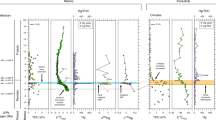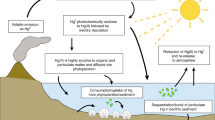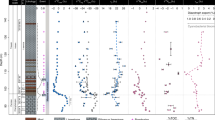Abstract
Carbon release rates from anthropogenic sources reached a record high of ∼10 Pg C yr−1 in 2014. Geologic analogues from past transient climate changes could provide invaluable constraints on the response of the climate system to such perturbations, but only if the associated carbon release rates can be reliably reconstructed. The Palaeocene–Eocene Thermal Maximum (PETM) is known at present to have the highest carbon release rates of the past 66 million years, but robust estimates of the initial rate and onset duration are hindered by uncertainties in age models. Here we introduce a new method to extract rates of change from a sedimentary record based on the relative timing of climate and carbon cycle changes, without the need for an age model. We apply this method to stable carbon and oxygen isotope records from the New Jersey shelf using time-series analysis and carbon cycle–climate modelling. We calculate that the initial carbon release during the onset of the PETM occurred over at least 4,000 years. This constrains the maximum sustained PETM carbon release rate to less than 1.1 Pg C yr−1. We conclude that, given currently available records, the present anthropogenic carbon release rate is unprecedented during the past 66 million years. We suggest that such a ‘no-analogue’ state represents a fundamental challenge in constraining future climate projections. Also, future ecosystem disruptions are likely to exceed the relatively limited extinctions observed at the PETM.
This is a preview of subscription content, access via your institution
Access options
Subscribe to this journal
Receive 12 print issues and online access
$259.00 per year
only $21.58 per issue
Buy this article
- Purchase on Springer Link
- Instant access to full article PDF
Prices may be subject to local taxes which are calculated during checkout




Similar content being viewed by others
References
Le Quéré, C. et al. Global carbon budget 2015. Earth Syst. Sci. Data 7, 349–396 (2015).
IPCC Climate Change 2013: The Physical Science Basis (eds Stocker, T. F. et al.) (Cambridge Univ. Press, 2013).
Zachos, J. C., Dickens, G. R. & Zeebe, R. E. An early Cenozoic perspective on greenhouse warming and carbon-cycle dynamics. Nature 451, 279–283 (2008).
Rohling, E. J. et al. Making sense of palaeoclimate sensitivity. Nature 491, 683–691 (2012).
Dickens, G. R., O’Neil, J. R., Rea, D. K. & Owen, R. M. Dissociation of oceanic methane hydrate as a cause of the carbon isotope excursion at the end of the Paleocene. Paleoceanography 10, 965–971 (1995).
Zachos, J. C., Pagani, M., Sloan, L., Thomas, E. & Billups, K. Trends, rhythms, and aberrations in global climate 65 Ma to present. Science 292, 686–693 (2001).
Zachos, J. C. et al. Rapid acidification of the ocean during the Paleocene–Eocene Thermal Maximum. Science 308, 1611–1615 (2005).
Zeebe, R. E., Zachos, J. C. & Dickens, G. R. Carbon dioxide forcing alone insufficient to explain Palaeocene-Eocene Thermal Maximum warming. Nature Geosci. 2, 576–580 (2009).
McInerney, F. A. & Wing, S. L. The Paleocene–Eocene Thermal Maximum: a perturbation of carbon cycle, climate, and biosphere with implications for the future. Annu. Rev. Earth Planet. Sci. 39, 489–516 (2011).
Rogner, H. An assessment of world hydrocarbon resources. Annu. Rev. Energy Environ. 22, 217–262 (1997).
McGlade, C. & Ekins, P. The geographical distribution of fossil fuels unused when limiting global warming to 2 °C. Nature 517, 187–190 (2015).
Ridgwell, A. & Schmidt, D. Past constraints on the vulnerability of marine calcifiers to massive carbon dioxide release. Nature Geosci. 3, 196–200 (2010).
Zeebe, R. E. & Zachos, J. C. Long-term legacy of massive carbon input to the Earth system: Anthropocene vs. Eocene. Phil. Trans. R. Soc. A 371, 20120006 (2013).
Farley, K. A. & Eltgroth, S. F. An alternative age model for the Paleocene-Eocene thermal maximum using extraterrestrial 3He. Earth Planet. Sci. Lett. 208, 135–148 (2003).
Murphy, B. H., Farley, K. A. & Zachos, J. C. An extraterrestrial 3He-based timescale for the Paleocene-Eocene thermal maximum (PETM) from Walvis Ridge, IODP Site 1266. Geochim. Cosmochim. Acta 74, 5098–5108 (2010).
John, C. M. et al. North American continental margin records of the Paleocene-Eocene thermal maximum: implications for global carbon and hydrological cycling. Paleoceanography 23, PA2217 (2008).
Hansen, J. et al. Climate response times: dependence on climate sensitivity and ocean mixing. Science 229, 857–859 (1985).
Roe, G. Feedbacks, timescales, and seeing red. Annu. Rev. Earth Planet. Sci. 37, 93–115 (2009).
Hansen, J., Sato, M., Kharecha, P. & von Schuckmann, K. Earth’s energy imbalance and implications. Atmos. Chem. Phys. 11, 13421–13449 (2011).
Zachos, J. C. et al. The Paleocene-Eocene carbon isotope excursion: constraints from individual shell planktonic foraminifer records. Phil. Trans. R. Soc. A 365, 1829–1842 (2007).
Stassen, P., Thomas, E. & Speijer, R. P. Integrated stratigraphy of the Paleocene-Eocene thermal maximum in the New Jersey Coastal Plain: toward understanding the effects of global warming in a shelf environment. Paleoceanography 27, PA4210 (2012).
Makarova, M., Miller, K. G., Wright, J. D., Rosenthal, Y. & Babila, T. Temperature and salinity changes associated with the Paleocene-Eocene Carbon Isotope Excursion along the mid Atlantic margin. AGU Fall Meeting abstr. PP33C–2322 (2015).
Wright, J. D. & Schaller, M. F. Evidence for a rapid release of carbon at the Paleocene-Eocene thermal maximum. Proc. Natl Acad. Sci. USA 110, 15908–15913 (2013).
Pearson, P. N. & Thomas, E. Drilling disturbance and constraints on the onset of the Paleocene-Eocene boundary carbon isotope excursion in New Jersey. Clim. Past 11, 95–104 (2015).
Zachos, J. C. et al. Extreme warming of mid-latitude coastal ocean during the Paleocene–Eocene Thermal Maximum: inferences from TEX86 and isotope data. Geology 34, 737–740 (2006).
Wei, W. W. S. Time Series Analysis: Inivariate and Multivariate Methods (Addison-Wesley, 1990).
Chatfield, C. The Analysis of Time Series: An Introduction 6th edn (CRC Press, 2004).
Box, G. E. P. & Jenkins, G. M. Time Series Analysis: Forecasting and Control (Holden-Day, 1970).
Zeebe, R. E. LOSCAR: long-term ocean-atmosphere-sediment carbon cycle reservoir model v2.0.4. Geosci. Model Dev. 5, 149–166 (2012).
Zeebe, R. E. Time-dependent climate sensitivity and the legacy of anthropogenic greenhouse gas emissions. Proc. Natl Acad. Sci. USA 110, 13739–13744 (2013).
Sluijs, A. et al. Environmental precursors to rapid light carbon injection at the Palaeocene/Eocene boundary. Nature 450, 1218–1221 (2007).
Bowen, G. J. et al. Two massive, rapid releases of carbon during the onset of the Palaeocene-Eocene thermal maximum. Nature Geosci. 8, 44–47 (2015).
Bralower, T. J., Meissner, K. J., Alexander, K. & Thomas, D. J. The dynamics of global change at the Paleocene-Eocene thermal maximum: a data-model comparison. Geochem. Geophys. Geosyst. 15, 3830–3848 (2014).
National Research Council Abrupt Impacts of Climate Change: Anticipating Surprises (The National Academies Press, 2013).
Robinson, A., Calov, R. & Ganopolski, A. Multistability and critical thresholds of the Greenland ice sheet. Nature Clim. Change 2, 429–432 (2012).
Caldeira, K. & Wickett, M. E. Anthropogenic carbon and ocean pH. Nature 425, 365 (2003).
Zeebe, R. E., Zachos, J. C., Caldeira, K. & Tyrrell, T. Oceans: carbon emissions and acidification (in perspectives). Science 321, 51–52 (2008).
Rockström, J. et al. A safe operating space for humanity. Nature 461, 472–475 (2009).
Acknowledgements
We thank E. Thomas for sharing data and G. Bowen for discussions. We gratefully acknowledge the NO.COM.ET project. This research was supported by NSF grant OCE12-20602 to J.C.Z. and R.E.Z. and EU grant ERC-2013-CoG-617313 to A.R.
Author information
Authors and Affiliations
Contributions
R.E.Z. led the effort. All authors wrote the paper.
Corresponding author
Ethics declarations
Competing interests
The authors declare no competing financial interests.
Supplementary information
Supplementary Information
Supplementary Information (PDF 1045 kb)
Rights and permissions
About this article
Cite this article
Zeebe, R., Ridgwell, A. & Zachos, J. Anthropogenic carbon release rate unprecedented during the past 66 million years. Nature Geosci 9, 325–329 (2016). https://doi.org/10.1038/ngeo2681
Received:
Accepted:
Published:
Issue Date:
DOI: https://doi.org/10.1038/ngeo2681
This article is cited by
-
Long-term application of agronomic management strategies effects on soil organic carbon, energy budgeting, and carbon footprint under rice–wheat cropping system
Scientific Reports (2024)
-
Pre-Cenozoic cyclostratigraphy and palaeoclimate responses to astronomical forcing
Nature Reviews Earth & Environment (2024)
-
Biochar ageing effects on soil respiration, biochar wettability and gaseous CO2 adsorption
Mitigation and Adaptation Strategies for Global Change (2024)
-
Reorganization of seagrass communities in a changing climate
Nature Plants (2023)
-
Shallow-water hydrothermal venting linked to the Palaeocene–Eocene Thermal Maximum
Nature Geoscience (2023)



